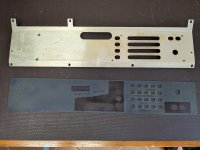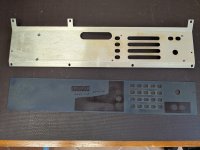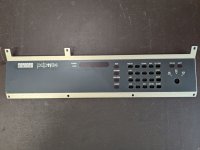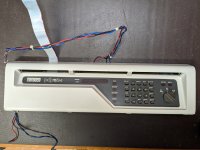thunter0512
Veteran Member
The PDP 11/34 and 11/04 front panels (both operator and programmer) use a somewhat stiff plastic sheet of 1.0 mm thickness with DEC logo, model designation, labels for the keys printed on it, cut-outs for the keypad and knob and red transparent sections for LEDs and 6 digit 7-segment display.
I don't know what the industry calls this type of plastic sheet? Is it a "decal"???
This plastic sheet is (was) fixed to an anodized aluminium plate (1.6 mm thickness) using some type of glue which has deteriorated so that the plastic sheet has separated from the aluminium plate.
The glue looks like it has been sprayed on and has a light yellowish-brown appearance. The glue readily dissolves in ethyl-alcohol and acetone, but is unaffected by water, petrol (gasoline) and dry cleaning fluid (white spirits).
I would like to glue the plastic sheet back onto the aluminium plate, but worry about damaging the plastic sheet by the solvents in typical glues like "contact glues".
Also "contact glues" don't allow any adjustment once you combine the two halves of mostly dried glue covered objects.
What type of plastic is this plastic sheet likely made of (polycarbonate?) and what paint was used? I am asking to determine what solvents may attack either the plastic sheet or the painted surfaces.
The dark grey and transparent red paints are applied to the back side of the plastic sheet, so they are vulnerable to solvent attack when glueing. I tried ethyl-alcohol in one corner which is obscured by the cast metal surround and some of the dark gray colour came off with the alcohol and gentle rubbing.
Has anyone successfully glued back the plastic sheet to the aluminium plate? If yes, what type of glue did you use and how exactly did you do the operation?
I don't know what the industry calls this type of plastic sheet? Is it a "decal"???
This plastic sheet is (was) fixed to an anodized aluminium plate (1.6 mm thickness) using some type of glue which has deteriorated so that the plastic sheet has separated from the aluminium plate.
The glue looks like it has been sprayed on and has a light yellowish-brown appearance. The glue readily dissolves in ethyl-alcohol and acetone, but is unaffected by water, petrol (gasoline) and dry cleaning fluid (white spirits).
I would like to glue the plastic sheet back onto the aluminium plate, but worry about damaging the plastic sheet by the solvents in typical glues like "contact glues".
Also "contact glues" don't allow any adjustment once you combine the two halves of mostly dried glue covered objects.
What type of plastic is this plastic sheet likely made of (polycarbonate?) and what paint was used? I am asking to determine what solvents may attack either the plastic sheet or the painted surfaces.
The dark grey and transparent red paints are applied to the back side of the plastic sheet, so they are vulnerable to solvent attack when glueing. I tried ethyl-alcohol in one corner which is obscured by the cast metal surround and some of the dark gray colour came off with the alcohol and gentle rubbing.
Has anyone successfully glued back the plastic sheet to the aluminium plate? If yes, what type of glue did you use and how exactly did you do the operation?




